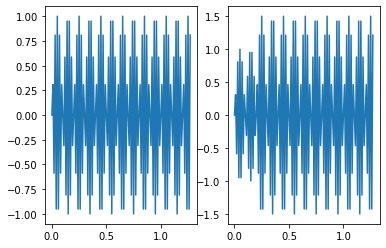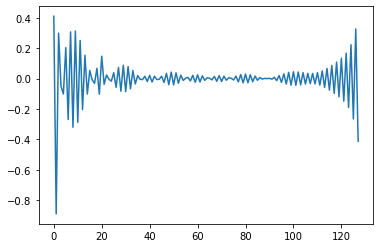网址:https://ww2.mathworks.cn/help/signal/ug/cepstrum-analysis.html
描述:本案例由2个示例构成
-
-
针对以上案例,采用Python语言实现。
-
python
import matplotlib.pyplot as plt
import numpy as np倒频谱分析是一种非线性信号处理方法,在语音和图像处理等领域有多种应用。
序列 x 的复倒频谱是通过求 x 的傅里叶变换的复自然对数,然后对得到的序列进行傅里叶逆变换来计算的
$ \widehat{x} = \frac{1}{2\pi}\int_{-\pi}^{\pi}log[X(e^{j\omega})]e^{j\omega n}d\omega $
python
t = np.array(np.arange(0,1.28,0.01),dtype = complex)
s1 = np.sin(2*np.math.pi*45*t)
s1.shape
s2 = s1+0.5*np.r_[np.zeros(20),s1[0:108]]首先,创建以 100 Hz 采样的 45 Hz 正弦波。在信号开始 0.2 秒后,添加一个幅值减半的回声。
python
plt.subplot(1,2,1)
plt.plot(t,s1)
plt.subplot(1,2,2)
plt.plot(t,s2)D:\anaconda\envs\pytorch\lib\site-packages\numpy\core\_asarray.py:83: ComplexWarning: Casting complex values to real discards the imaginary part
return array(a, dtype, copy=False, order=order)
D:\anaconda\envs\pytorch\lib\site-packages\numpy\core\_asarray.py:83: ComplexWarning: Casting complex values to real discards the imaginary part
return array(a, dtype, copy=False, order=order)
[<matplotlib.lines.Line2D at 0x17a010cb198>]

计算并绘制新信号的复倒频谱。
python
spectrum = np.fft.fft(s2)
ceps = np.fft.ifft(np.log(spectrum))python
plt.plot(ceps)D:\anaconda\envs\pytorch\lib\site-packages\numpy\core\_asarray.py:83: ComplexWarning: Casting complex values to real discards the imaginary part
return array(a, dtype, copy=False, order=order)
[<matplotlib.lines.Line2D at 0x17a0120d240>]

-
对复倒频谱求逆
python
x = np.arange(1,11,1)
spectrum2 = np.fft.fft(x)
ceps2 = np.fft.ifft(np.log(spectrum2))
xarray([ 1, 2, 3, 4, 5, 6, 7, 8, 9, 10])
$ c_x = \frac{1}{2\pi}\int_{-\pi}^{\pi}log[X(e^{j\omega})]e^{j\omega n}d\omega $
python
cc = np.fft.fft(ceps2)
# cc = np.abs(cc)
cc2 = np.exp(cc)
cc3 = np.fft.ifft(cc2).realpython
cc3array([ 1., 2., 3., 4., 5., 6., 7., 8., 9., 10.])
